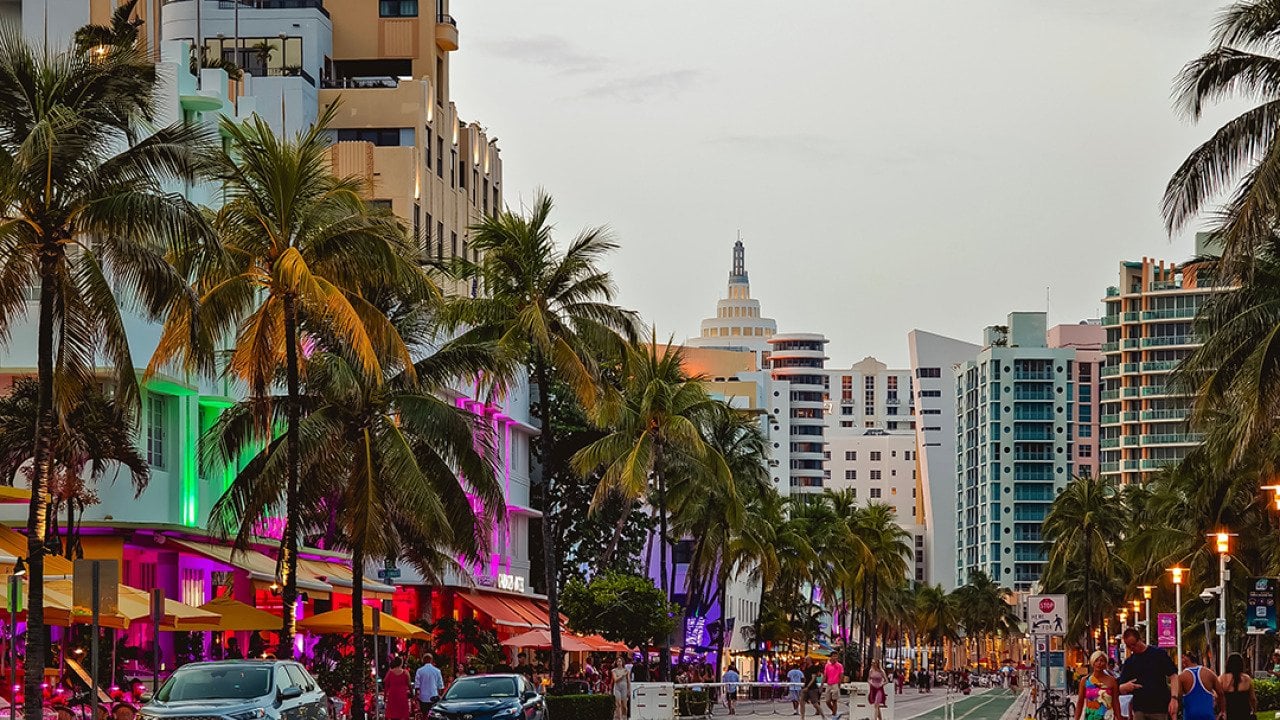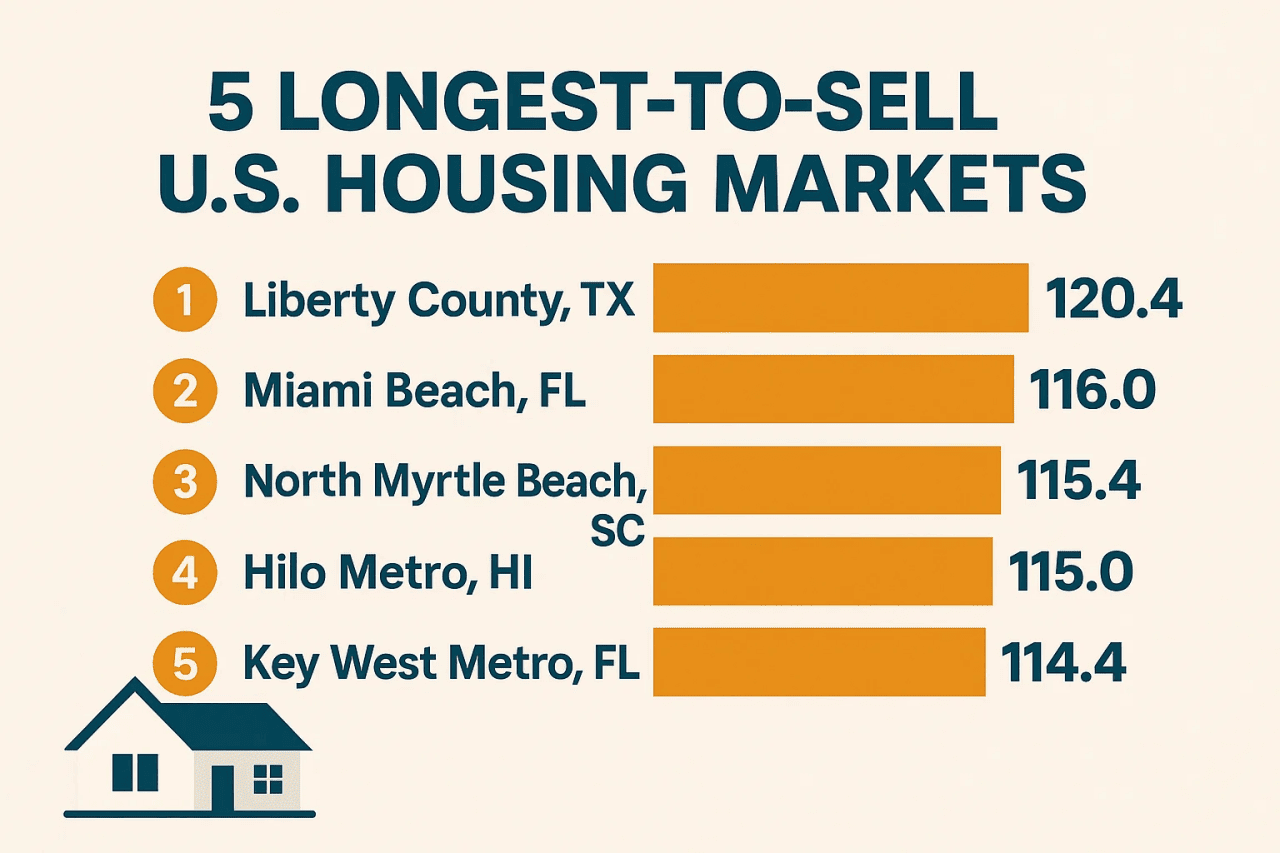Where homes are taking the longest to sell and why

MDV Edwards // Shutterstock
Where homes are taking the longest to sell and why
The housing market is necessarily fragmented, meaning there can be stark gulfs between asking prices and buyer demand even on a street-by-street or neighborhood-by-neighborhood basis.
The focus of many real estate industry analysts is therefore on the hottest niches, where prices are eye-watering and homes spend less than a week on the market before a buyer is found.
However, there’s just as much intrigue and strategically relevant conclusions to be drawn from those areas sitting at the other end of the scale. These are the towns, cities, and counties with the highest average days on market (DOM), an inauspicious accolade with multiple causes and symptoms.
To learn lessons from property market data, you have to understand why the figures have been chosen, as well as what they say about the markets that are being put under the magnifying glass. So, without further delay, Offerpad shares the places with the least enviable average DOM and the often counterintuitive explanations behind this phenomenon.
Defining DOM and Justifying Data Choices
Before introducing the markets themselves, it’s important to understand what DOM means and how these markets were selected from the thousands of distinct regions within the national real estate sector.
First, the DOM figure for a given area is calculated by summing the time it took each home sold from January to May to find a buyer, then dividing by the total number of properties to find an average. The higher this figure, the longer it took for a typical piece of real estate to sell.
For context, the region with the lowest average days on market for the first half of 2025 was Monroe County, New York. Here, sellers could reasonably expect to find a buyer in just 10 days. As you’ll see, this is a far cry from average DOMs at the upper end of the spectrum.
Next, there are several parameters set for picking the bottom 10 markets. The main filter applied by Offerpad is total sales for January to May 2025. Only markets with at least 500 real estate transactions were included. The purpose was to eliminate very small markets from contention, as these tend to have the biggest variances in DOM over shorter periods of time, and would thus not be representative of broader market trends.
Regions Hampered by the High DOM Dilemma
Now there’s clarity in terms of the what and the why, it’s time to unpack the ins and outs of which places are at the bottom of the average DOM pile and the root issues behind their current conundrum.

Offerpad
Liberty County, Texas
The top of the list, but the bottom of the pile in terms of average DOM, is Texas’ 42nd largest county. With a population of a little over 91,000 and home sales in the first half of the year hitting 501, it just scrapes into the criteria defined for this analysis. However, it’s an interesting case study for a few reasons.
Across those 501 sales, the average DOM in Liberty County sat at 120.4 days. This implies that the market is definitely stagnant, with few sales and few buyers competing for them.
One factor at play here is the county’s economy, specifically in terms of employment. As of May 2025, the county had an unemployment rate of 5.1% compared to the national average of 4.2%.
Another issue is that housing is comparatively expensive in Liberty County. In the past year, average home prices have risen by 14%, exceeding $286,000 in May 2025. The median price nationally is at a little over $440,000, but it’s all relative. People looking to buy in this region don’t have the same means or motivation as those in other, faster-moving and more economically buoyant markets.
The final point of note is that a market like Liberty County suffers not only from sluggish internal activity but also from diminished interest from the outside. If property prices are comparatively high and employment levels are low, there’s little incentive for real estate investors to take a risk on this region, nor for out-of-state movers to buy. It’s not among the best places to live in Texas for all these reasons and more.
Florida’s Coast
Florida fills three positions in the top 10 locations with the highest average DOM. What’s particularly notable about this is that these locations are all coastal.
Specifically:
- Miami Beach – 116 DOM – 833 sales
- Key West metro – 114.4 DOM – 720 sales
- Monroe County – 113.8 DOM – 721 sales
In short, none are that far behind Liberty County when it comes to how quickly houses sell — or rather, don’t sell. Yet on paper, they are worlds apart in every other respect.
Take Miami as an example. It has an unemployment rate of around 2.4% at the moment, and a median house price of approximately $620,000. By all accounts and metrics, it is a wealthy city. Yet the housing market is almost as sluggish as an obscure county in semirural Texas.
The explanation is just as multifaceted as you might expect by this point. Coastal regions have their share of real estate-related complexities that either don’t exist or are far less pressing in inland equivalents.
First, there’s the increased likelihood of climate-related catastrophes, which is felt especially acutely throughout Florida. Floods and hurricanes are the norm in this part of the country, and this causes more caution among buyers, not just because of the potential for property damage, but for the increased insurance costs that go along with it. Rising sea levels are a long-term concern as well.
Since a sizable proportion of sales in Florida, particularly in the coastal locations where average DOM figures are high, will be second homes, they are more susceptible to external factors. Chiefly, the rise in interest rates hits buyers in this segment harder, as rates are typically higher for second-home mortgages. Even opting for a 30-year fixed deal means committing to rates of 6.75% on average as of July 17. Short-term deals are only marginally better than this.
South Carolina’s Coast
The next coastal region facing a DOM crisis is South Carolina, although things are not as bad as they might seem at first when you look into the realities of the market on the maritime fringes of this state.
The three South Carolina markets in the rankings are:
- North Myrtle Beach – 115.4 DOM – 716 sales
- Myrtle Beach – 111.4 DOM – 746 sales
- Horry County – 110.2 DOM – 5,464 sales
Being coastal communities, these places share similar issues with Florida’s seaside towns, cities and counties in terms of buyer hesitancy over climate events and insurance costs. However, there’s another aspect involved here that’s important to touch on: age.
The average age of Horry County residents is currently hovering just below 50 as of 2023. This contrasts significantly with the national average of 39.1 in 2024, and is an effect of the fact that South Carolina’s coastal regions are a popular choice for retirement. In turn, this indicates that a lot of buyers will be moving from out of state, and thus face a process that’s more complex and more emotionally significant, naturally slowing down the decision-making process.
Likewise, many buyers may be focused on investing in property to take advantage of the tourism market in places like Myrtle Beach. In this case, the pressures on real estate differ because they may depend on elements such as the ebb and flow of visitors.
Hawai’i
The trend established in terms of coastal regions being the slowest for house sales continues with two Hawai’i locations cropping up in this list.
These are:
- Hilo metro area – 115 DOM – 955 sales
- Hawai’i County – 112.6 DOM – 935 sales
Once more, it’s reasonable to assume that a combination of the aforementioned factors that slow down markets in regions like this is in the mix in Hawai’i. Economic issues, concerns over extreme weather and climate change, a preponderance of out-of-state buyers and high relative house prices create the perfect storm, preventing average DOM figures from falling to more acceptable levels.
That said, both Hilo and Hawai’i County benefit from better-than-expected sales volumes in the period analyzed. As a result, it could be argued that macroeconomic factors are less relevant here, and instead, there’s a degree of localized friction exerted upon sales at the moment; friction that may be temporary and short-term rather than a longer-lasting trend.
The Luxury Factor
Before wrapping things up, it’s worth circling back to touch on Miami’s appearance among the places with the highest DOM for homes. This is a relatively unique market as a result of its status as a luxury hotspot for the rich and famous, which brings with it a series of related concerns that create a bottleneck in the real estate sector, rather than catalyzing it.
At the very top end of the market in terms of price, specifically condos in the city that sell for over $1 million, there has actually been strong growth in recent months. However, it’s in the mid tier, where volumes are higher, that there’s more of an oversupply issue, only exacerbated further by interest rates that refuse to shift downwards fast enough for the more averagely affluent buyer.
This issue is compounded by the fact that Miami is a market where there are many homeowner associations in place, bringing with them a raft of restrictions that both prevent a wide audience of buyers from getting their foot in the door and stall out the sales process. Coupled with the large number of overseas buyers looking to get into the market, but facing their own set of hurdles, Miami’s place on this list is easier to understand.
Final Thoughts
Parts of the country where homes take the longest to sell certainly share a few common traits, regardless of the sales volumes involved.
Coastal communities, through a combination of climate concerns, tourism industry fluctuations, out-of-state movers, and insurance costs, are most likely to see DOM levels rise well above averages for the country as a whole.
Even luxury destinations like Miami are not immune to external pressures, or indeed to internal market wrangling and sticking points like HOA requirements.
Then there are oddities like Liberty County, Texas. Here, the problems with property market stagnation seem primarily economic, although there’s never just one factor involved, and it pays to look closer at the data before jumping to conclusions.
Ultimately, the top-level influences of mortgage rates and home insurance costs will continue to grab the attention of buyers, sellers, and realtors alike. Those who take the time to go beyond the superficial reasons behind a market’s momentum always have the upper hand.
This story was produced by Offerpad and reviewed and distributed by Stacker.
![]()



